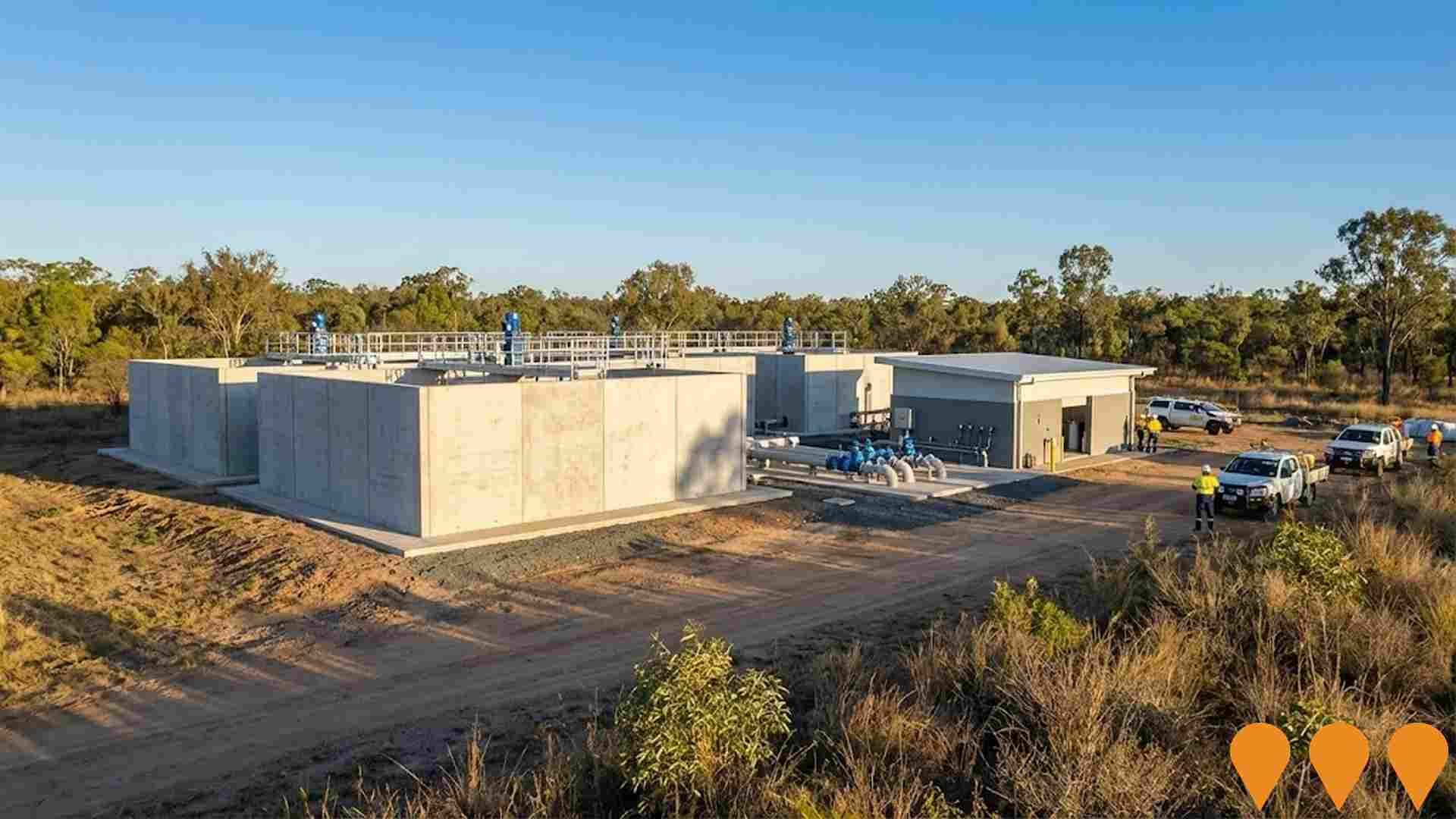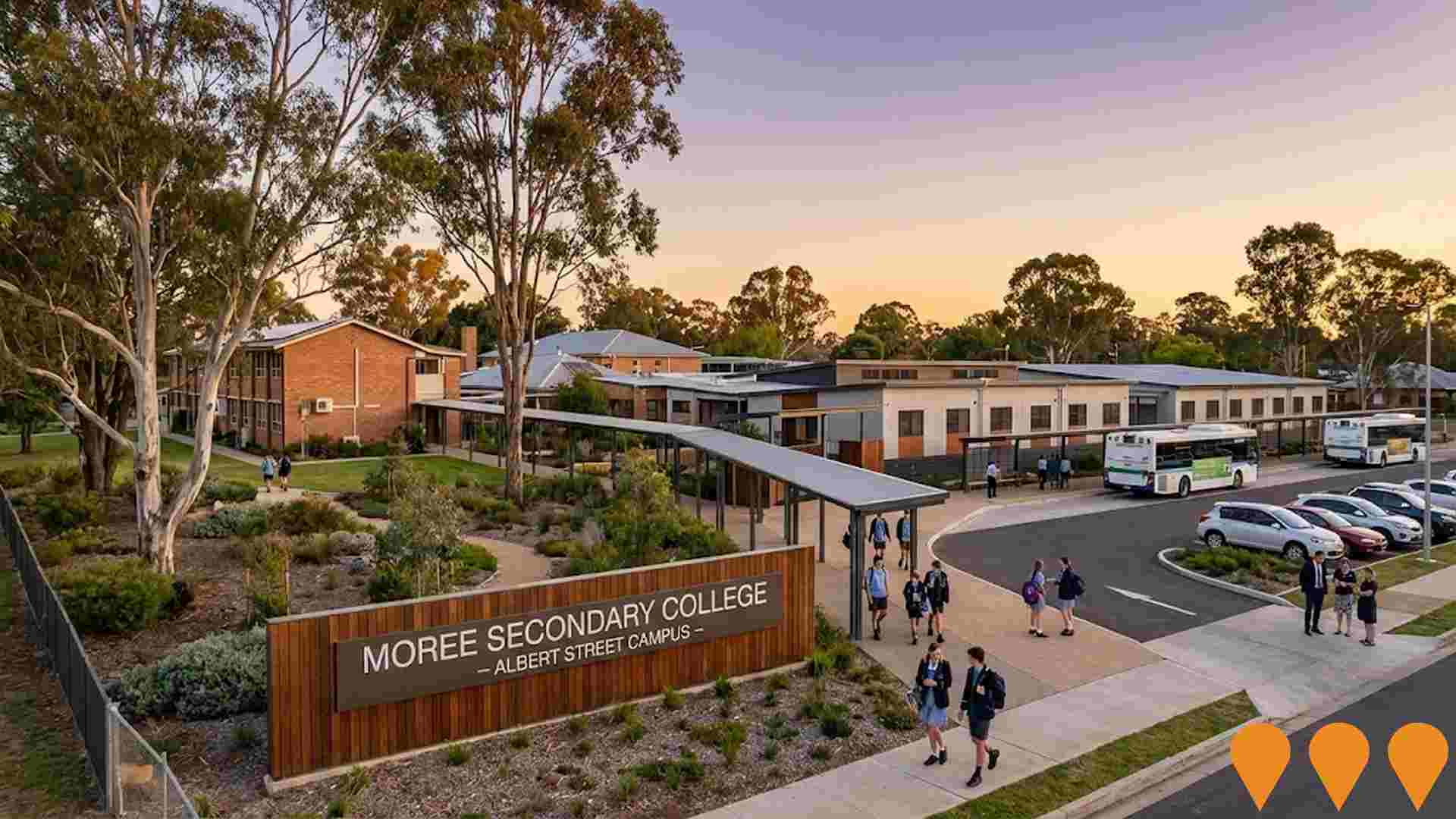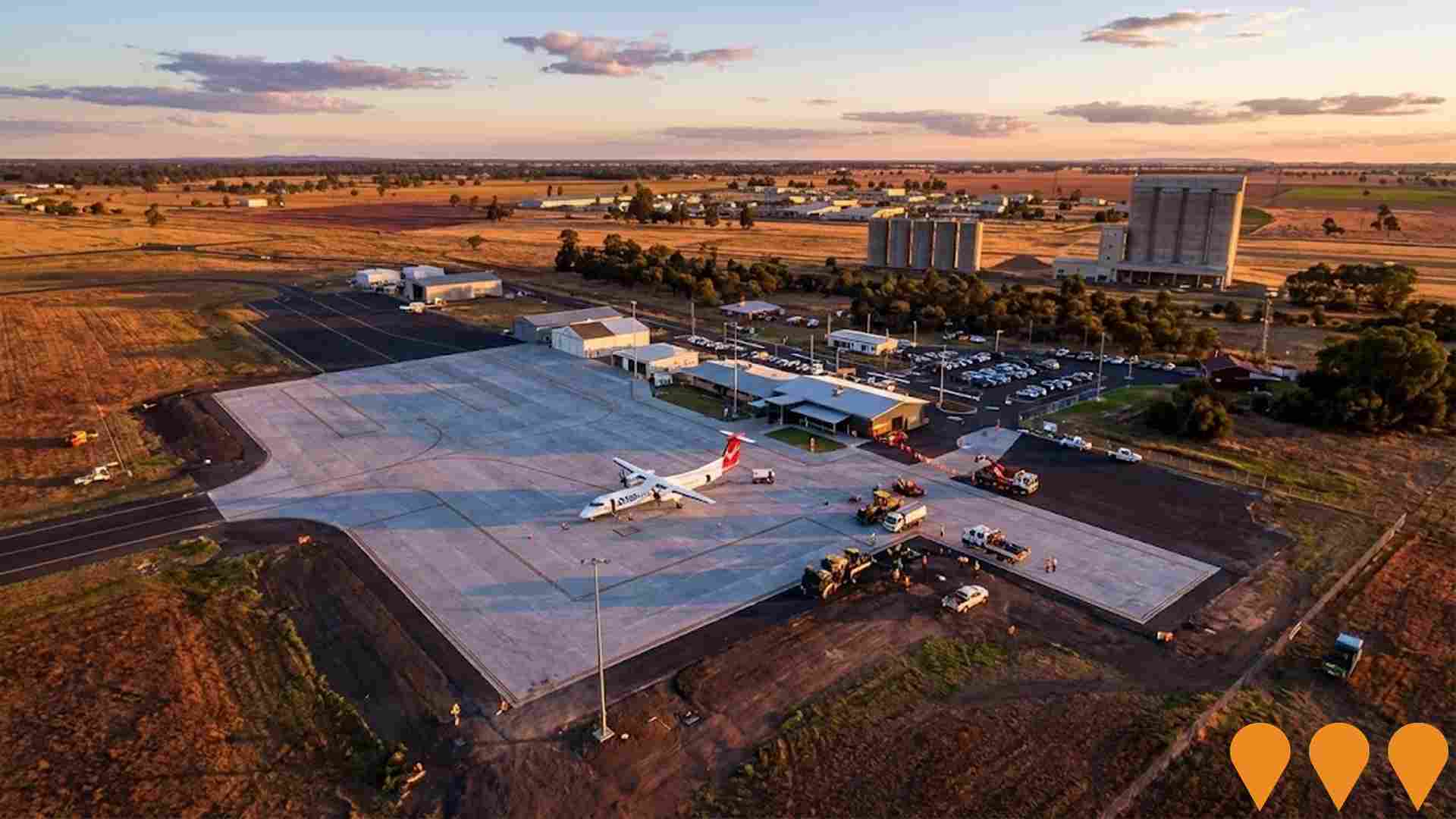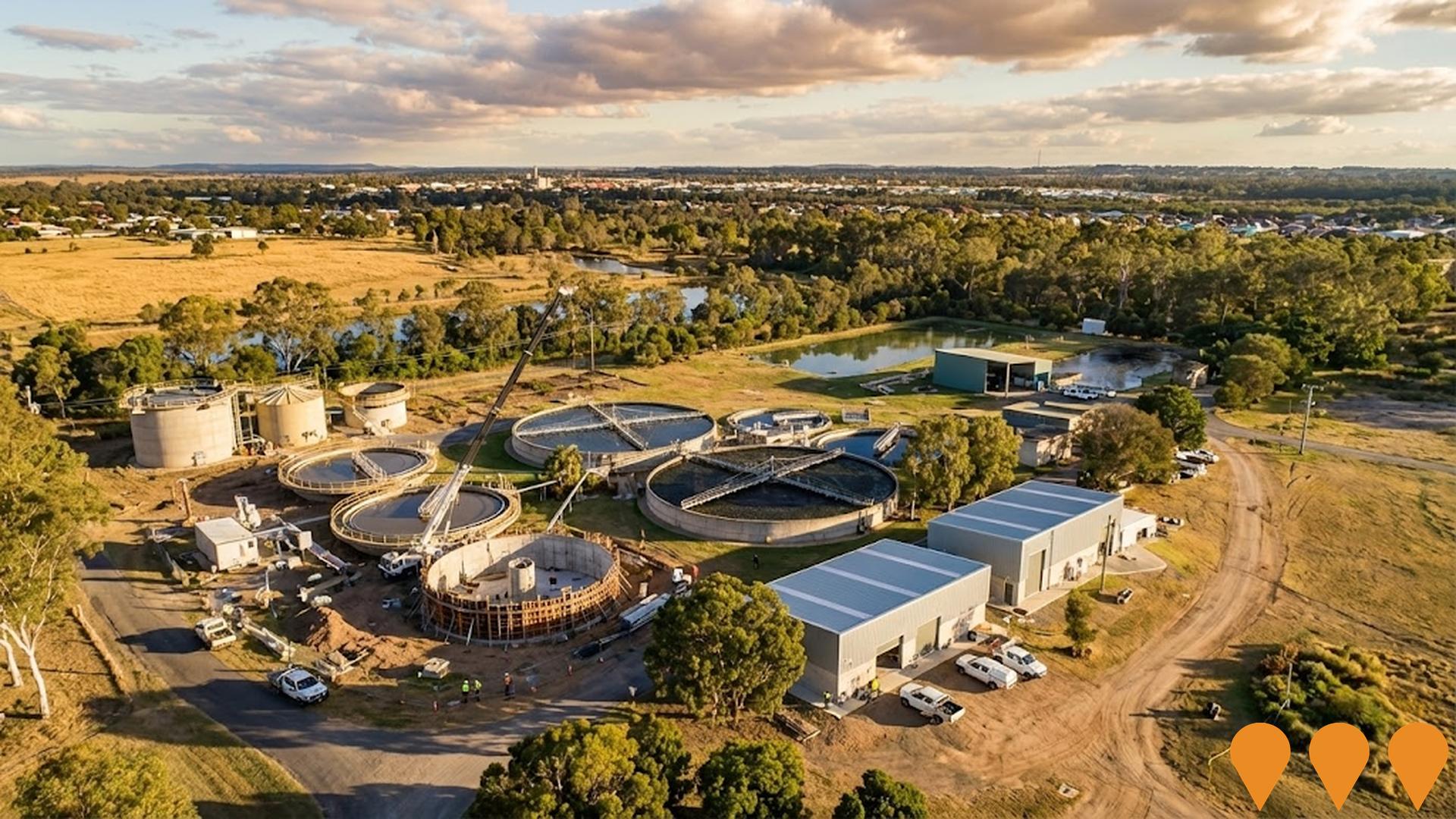Chart Color Schemes
est. as @ -- *
ABS ERP | -- people | --
2021 Census | -- people
Sales Activity
Curious about local property values? Filter the chart to assess the volume and appreciation (including resales) trends and regional comparisons, or scroll to the map below view this information at an individual property level.
Find a Recent Sale
Sales Detail
Population
Moree Surrounds is positioned among the lower quartile of areas assessed nationally for population growth based on AreaSearch's assessment of recent, and medium term trends
Based on AreaSearch's analysis, Moree Surrounds' population is around 5330 as of November 2025. This reflects a decrease of 26 people (0.5%) since the 2021 Census, which reported a population of 5356 people. The change is inferred from the estimated resident population of 5263 from the ABS as of June 2024 and an additional 20 validated new addresses since the Census date. This level of population equates to a density ratio of 0.30 persons per square kilometer. While Moree Surrounds experienced a 0.5% decline since census, the SA3 area achieved 0.3% growth, highlighting divergent population trends. Population growth for the area was primarily driven by natural growth that contributed approximately 90.8% of overall population gains during recent periods.
AreaSearch is adopting ABS/Geoscience Australia projections for each SA2 area, as released in 2024 with 2022 as the base year. For any SA2 areas not covered by this data, AreaSearch is utilising the NSW State Government's SA2 level projections, as released in 2022 with 2021 as the base year. Growth rates by age group from these aggregations are also applied to all areas for years 2032 to 2041. Examining future population trends, a population increase just below the median of Australia's non-metropolitan areas is expected, with the area expected to increase by 519 persons to 2041 based on the latest population numbers, reflecting an increase of 8.5% in total over the 17 years.
Frequently Asked Questions - Population
Development
The level of residential development activity in Moree Surrounds is very low in comparison to the average area assessed nationally by AreaSearch
Moree Surrounds had minimal residential development activity with 2 dwelling approvals annually over the five-year period from 2016 to 2020, totalling 13 dwellings. This low level of development reflects its rural nature, where housing needs drive development rather than broad market demand. The small number of approvals means individual projects can significantly impact annual growth statistics.
Compared to Rest of NSW and national patterns, Moree Surrounds has much lower development activity. New building activity was 50% standalone homes and 50% townhouses or apartments, indicating a shift from the current housing mix of 93% houses. This change is due to reduced availability of development sites and shifting lifestyle demands and affordability requirements. As of 2021, there were an estimated 3301 people per dwelling approval in Moree Surrounds. Population forecasts indicate the area will gain 452 residents by 2041. If current construction levels persist, housing supply may lag population growth, potentially intensifying buyer competition and supporting price growth.
Population forecasts indicate Moree Surrounds will gain 452 residents through to 2041. Should current construction levels persist, housing supply could lag population growth, likely intensifying buyer competition and underpinning price growth.
Frequently Asked Questions - Development
Infrastructure
Moree Surrounds has emerging levels of nearby infrastructure activity, ranking in the 38thth percentile nationally
Changes to local infrastructure can significantly impact an area's performance. AreaSearch has identified 15 projects that may affect the region. Notable initiatives include Moree Secondary College Campus Consolidation, Moree Hospital Redevelopment, Inland Rail - Narrabri to North Star - Phase Two, and Moree Water Treatment Plant Upgrades. The following list details those most likely to be relevant.
Professional plan users can use the search below to filter and access additional projects.
INFRASTRUCTURE SEARCH
 Denotes AI-based impression for illustrative purposes only, not to be taken as definitive under any circumstances. Please follow links and conduct other investigations from the project's source for actual imagery. Developers and project owners wishing us to use original imagery please Contact Us and we will do so.
Denotes AI-based impression for illustrative purposes only, not to be taken as definitive under any circumstances. Please follow links and conduct other investigations from the project's source for actual imagery. Developers and project owners wishing us to use original imagery please Contact Us and we will do so.
Frequently Asked Questions - Infrastructure
Moree Hospital Redevelopment
AUD170 million Stage 2 redevelopment of Moree Hospital delivering a new four-storey Acute Services Building with expanded emergency department, two operating theatres, medical imaging, birthing suite, inpatient units, pathology, and a new main entry. Works also include refurbishment of existing facilities. Hutchinson Builders appointed as managing contractor under a GMP construct-only contract. Construction commenced June 2025; practical completion expected late 2027. All clinical services remain fully operational throughout construction.

Moree Special Activation Precinct (SAP)
A 4,716-hectare Special Activation Precinct designated for high-value agribusiness, logistics, and food processing industries. Enabling works (sewer and water) are nearing completion as of late 2025. Stage 1 major infrastructure works, including road upgrades and utility connections to support the intermodal freight hub, are scheduled to commence construction in 2026.

Yelarbon and Talwood water quality project
Upgrade of the Yelarbon and Talwood water treatment systems to improve potable water quality. Works included installing new reservoir mixers at both sites, a new chlorine system at Yelarbon and modifications to the existing chlorination system at Talwood. Council reported the project was on track for completion by June 2024, supporting safer, more consistent disinfection and water quality for both towns.

Narrabri Solar Farm and BESS
A 140 MW DC solar farm with a 100 MW / 800 MWh battery energy storage system on approximately 312 hectares of private rural land. The project will generate enough renewable energy to power approximately 35,000 homes and offset around 182,000 tonnes of CO2 annually. It will connect to the existing 132 kV transmission line and contribute to the National Electricity Market.

Goondiwindi Hydrogen
The Goondiwindi Regional Council, in partnership with The Hydrogen Collective (H2C), is developing a renewable hydrogen production facility at the Goondiwindi wastewater treatment plant. It utilizes a 2.5 MW solar array and wastewater to produce green hydrogen for local agricultural and industrial use, with oxygen byproduct enhancing wastewater treatment efficiency. Stage 1 includes a 2 MW electrolyser producing approximately 300 tonnes of hydrogen per annum.

Moree Secondary College Campus Consolidation
The project consolidated Moree Secondary College's two campuses into a single operational campus at Albert Street, with associated minor upgrades and works to enable one-site delivery from Term 1 2024.

Moree East Public School Redevelopment
Substantial rebuild and refurbishment of Moree East Public School delivering around 15 new and refurbished classrooms, two shared learning spaces, a new hall and library, and upgrades to community hub facilities to support modern teaching and learning.

Moree Regional Airport Upgrades
Staged upgrades to Moree Regional Airport led by Moree Plains Shire Council to increase capacity and resilience for passenger, freight and aeromedical operations supporting the Moree Special Activation Precinct. Works completed/underway include multi-stage apron expansion enabling Q400 operations, with additional funding secured in Feb 2025 to upgrade the aeromedical apron, taxiway and parking bays to create a 24-hour aeromedical facility. Future stages flagged in planning documents include terminal improvements and potential runway enhancements aligned to SAP growth.

Employment
Employment performance in Moree Surrounds ranks among the strongest 15% of areas evaluated nationally
Moree Surrounds has a skilled workforce with diverse sector representation and an unemployment rate of 1.7% as of June 2025. In the past year, employment grew by an estimated 4.4%.
The area's unemployment rate is 1.9% lower than Rest of NSW's rate of 3.7%, but workforce participation is slightly below standard at 53.7%. Key industries of employment among residents are agriculture, forestry & fishing, education & training, and health care & social assistance. Moree Surrounds shows strong specialization in agriculture, forestry & fishing with an employment share 9.5 times the regional level. However, health care & social assistance is under-represented at 6.8% compared to Rest of NSW's 16.9%.
Employment opportunities locally appear limited based on Census working population vs resident population comparison. In the 12-month period ending June 2025, employment increased by 4.4%, labour force grew by 3.7%, and unemployment fell by 0.7 percentage points. This contrasts with Rest of NSW where employment fell by 0.1%, labour force expanded by 0.3%, and unemployment rose by 0.4 percentage points. Jobs and Skills Australia's national employment forecasts from May 2025 project national employment growth of 6.6% over five years and 13.7% over ten years, with varying rates between industry sectors. Applying these projections to Moree Surrounds' employment mix suggests local growth of approximately 4.4% over five years and 10.2% over ten years.
Frequently Asked Questions - Employment
Income
Income levels sit below national averages according to AreaSearch assessment
AreaSearch released postcode level ATO data for financial year 2022. Moree Surrounds' median income among taxpayers was $49,134, with an average of $59,163. This is below the national average. The median income in Rest of NSW was $49,459, and the average was $62,998. Based on Wage Price Index growth since financial year 2022, current estimates for Moree Surrounds would be approximately $55,330 (median) and $66,623 (average) as of September 2025. Census data shows household, family, and personal incomes rank modestly in Moree Surrounds, between the 43rd and 53rd percentiles. The earnings profile reveals that 32.2% of the population, or 1,716 individuals, fall within the $1,500 - $2,999 income range, similar to patterns seen in metropolitan regions where 29.9% occupy this range. After housing costs, residents retain 93.5% of their income, reflecting strong purchasing power. The area's SEIFA income ranking places it in the 5th decile.
Frequently Asked Questions - Income
Housing
Moree Surrounds is characterized by a predominantly suburban housing profile, with above-average rates of outright home ownership
In Moree Surrounds, as per the latest Census evaluation, 93.0% of dwellings were houses, with the remaining 7.0% being semi-detached, apartments, or other types. This compares to Non-Metro NSW's figures of 87.8% houses and 12.1% other dwellings. Home ownership in Moree Surrounds stood at 42.9%, with mortgaged dwellings at 25.9% and rented ones at 31.2%. The median monthly mortgage repayment was $867, lower than Non-Metro NSW's average of $1,300. The median weekly rent figure in Moree Surrounds was $175, compared to Non-Metro NSW's $220. Nationally, mortgage repayments were significantly lower at $867 versus Australia's average of $1,863, and rents were substantially below the national figure of $375.
Frequently Asked Questions - Housing
Household Composition
Moree Surrounds has a typical household mix, with a higher-than-average median household size
Family households constitute 71.7% of all households, composed of 31.1% couples with children, 28.4% couples without children, and 10.8% single parent families. Non-family households account for the remaining 28.3%, with lone person households at 26.0% and group households comprising 2.1% of the total. The median household size is 2.6 people, larger than the Rest of NSW average of 2.5.
Frequently Asked Questions - Households
Local Schools & Education
Educational outcomes in Moree Surrounds fall within the lower quartile nationally, indicating opportunities for improvement in qualification attainment
The area's university qualification rate is 19.6%, significantly lower than NSW's average of 32.2%. Bachelor degrees are the most common at 15.7%, followed by graduate diplomas (2.5%) and postgraduate qualifications (1.4%). Vocational credentials are prevalent, with 41.9% of residents aged 15+ holding them, including advanced diplomas (12.5%) and certificates (29.4%). Educational participation is high at 42.6%, with 18.8% in primary education, 11.1% in secondary education, and 4.7% pursuing tertiary education.
Twelve schools serve 351 students in the area, which has varied educational conditions across Moree Surrounds. The educational mix includes ten primary and two K-12 schools. Local school capacity is limited at 6.6 places per 100 residents compared to the regional average of 14.6, leading many families to travel for schooling.
Frequently Asked Questions - Education
Schools Detail
Nearby Services & Amenities
Transport
Transport servicing is low compared to other areas nationally based on assessment of service frequency, route connectivity and accessibility
Analysis of public transport in Moree Surrounds indicates 254 active transport stops operating within the area. These consist of a mix of train and bus services. The stops are serviced by 27 individual routes which collectively provide 281 weekly passenger trips.
Transport accessibility is rated as limited, with residents typically located 2841 meters from the nearest transport stop. Service frequency averages 40 trips per day across all routes, equating to approximately 1 weekly trip per individual stop.
Frequently Asked Questions - Transport
Transport Stops Detail
Health
The level of general health in Moree Surrounds is notably higher than the national average with both young and old age cohorts seeing low prevalence of common health conditions
Moree Surrounds shows above-average health outcomes for both younger and older age groups, with low prevalence of common health conditions. Approximately 49% (~2,617 people) have private health cover, lower than the national average of 55.3%.
The most prevalent medical conditions are asthma (8.5%) and arthritis (6.8%). A higher proportion, 72.9%, report being free from medical ailments compared to 66.7% in Rest of NSW. The area has 15.7% (836 people) aged 65 and over, lower than the 18.8% in Rest of NSW. Health outcomes among seniors are notably strong, exceeding those of the general population in health metrics.
Frequently Asked Questions - Health
Cultural Diversity
The latest Census data sees Moree Surrounds placing among the least culturally diverse areas in the country when compared across a range of language and cultural background related metrics
Moree Surrounds had a cultural diversity index below the average, with 72.9% of its population being Australian citizens, 94.6% born in Australia, and 96.9% speaking English only at home. Christianity was the predominant religion in Moree Surrounds, accounting for 68.2% of the population, which is similar to the 68.1% regional average across Rest of NSW. The top three ancestry groups were Australian (29.9%), English (29.4%), and Australian Aboriginal (12.3%).
Notably, Irish ancestry was overrepresented at 9.9%, compared to 8.1% regionally, Scottish at 8.5% versus 6.8%, and German at 3.9% against 2.8%.
Frequently Asked Questions - Diversity
Age
Moree Surrounds's population is slightly older than the national pattern
The median age in Moree Surrounds is 39 years, which is significantly lower than Rest of NSW's average of 43 but essentially aligned with Australia's median age of 38 years. Compared to Rest of NSW, Moree Surrounds has a higher percentage of residents aged 25-34 (15.1%) but fewer residents aged 75-84 (4.8%). According to the 2021 Census, the population aged 25 to 34 grew from 12.5% to 15.1%, while the 45 to 54 age group declined from 14.1% to 11.6% and the 35 to 44 age group decreased from 11.6% to 10.6%. By 2041, demographic projections indicate significant shifts in Moree Surrounds' age structure. The 25 to 34 age group is projected to grow by 32%, reaching 1,064 people from the current 805. Conversely, the 5 to 14 and 15 to 24 age groups are expected to experience population declines.



